Airport Extreme (5th Gen) and Time Capsule (4th Gen) Review - Faster WiFi
by Brian Klug on August 5, 2011 10:22 PM EST- Posted in
- Mac
- Airport Extreme
- Time Capsule
- WiFi
Airport Utility and Network
The only remaining thing to go over is the Airport Utility and general network functionality. I’m not going to go into very much detail at all about the network side of things (routing performance, etc.) since honestly nothing has changed here—the board and SoC are the exact same.
To start, all configuration is done through Airport Utility on OS X and Windows. There’s no web-based portal like just about every other attached network device. On all of Apple’s WiFi products, Airport Utility is the exclusive point of configuration. It pops up a list of devices, including unconfigured ones without the need to connect over ethernet. Admittedly that’s a nice touch that makes configuration super easy.
There’s either the choice to have a wizard set everything up, or you can do it manually. The first page is summary, which lists some basic information, status, and high level information. Status mirrors the front panel LED which either glows green or amber depending on whether things are working fine.
For example, when the Time Capsule starts overheating the LED blinks amber and pops up an alert. The utility can also monitor for when problems happen.
The rest of configuration is honestly pretty straightforward. Each of the radios (2.4 and 5GHz) can be set to its own SSID, there are a wide selection of radio modes and the ability to set channels manually. As an aside, if you’re going to set the 5GHz channel manually, select one over 149 to get maximum power and avoid dynamic frequency selection chanels in the US.
There’s honestly everything you’d want from a consumer level router or wireless AP, and a couple of extras like RADIUS server support and guest network creation.
If you run the devices as a router, you can also port forward, configure the DHCP server (including static addresses assigned to specific MACs), and all the usual fixings. That said, some of the options are a bit barebones compared to more enthusiast open source packages, but it gets the job done.
In addition to sharing disks, the Airports can also share printers attached using USB. I’ve experimented around and even a USB hub plugged in with devices attached to it works, so you’re not limited to just a single port.
One of the features Airport Utility has that a lot of other consumer devices don’t is a nice way of viewing the status of attached wireless clients, including a little graph that continually tracks. The utility will show each client MAC address, signal, noise level, rate, and what network mode they’re using. It’s an incredibly useful diagnostic tool that’s honestly a step beyond what Tomato or even DD-WRT report for clients.
The Windows version of Airport Utility looks a bit like a program from the Windows XP days, which is about par but not unforgivable. Everything inside works the same way, except this version forgoes the client signal graph and instead just presents a table with data. You can still do everything else, however.
Update: Our own Saumitra Bhagwat pointed out to me that on iOS 5 Beta, you can actually use an Airport Utility (lite) built into the WiFi settings page to configure a new Airport Extreme or Time Capsule. You have to be in the initial setup state (reset completely to defaults) to see it, but when in range, a "setup an airport base station" window appears, allowing this lite level of configuration. Depending on your existing setup, it'll offer some suggestions as well (for example, as I'm attached to a current Extreme, it offers to extend by default).
Another small but useful thing is that both devices support SNMP, so you can do stuff like track traffic on all the internal interfaces on the device using software like MRTG or Cacti (both of which I’m a huge fan of). There’s even a MIB for how many wireless clients are joined. If you’re not into using SNMP yourself, there’s a simple utility out there called Airport Flow that gives you a per-interface graph and the total number of clients attached.
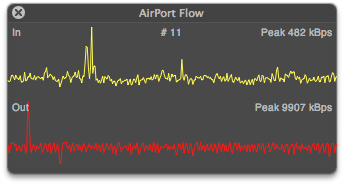
You need to specify the device IP address and what interface to monitor, so you might have to snmpwalk the airport (snmpwalk -c public [ip addy]) and look for the line with each interface name:
IF-MIB::ifDescr.1 = STRING: mgi0IF-MIB::ifDescr.2 = STRING: mgi1IF-MIB::ifDescr.3 = STRING: bwl0IF-MIB::ifDescr.4 = STRING: bwl1IF-MIB::ifDescr.5 = STRING: lo0IF-MIB::ifDescr.6 = STRING: wlan0IF-MIB::ifDescr.7 = STRING: wlan1IF-MIB::ifDescr.8 = STRING: bridge0
But there’s nothing complicated about that.
Honestly, for routing and firewall, the Time Capsule and Airport Extreme get the job done but without much flair or ability to tweak low level things like I’d like to see. I generally use either a pfSense embedded x86 box, WRT54G-TM running Tomato, or a WRT-600 running DD-WRT for NAT routing, firewall, and DHCP myself, just because those options offer a ton of fine grained control over the network side, and then an Airport Extreme for WLAN. That said, the Time Capsule or Airport Extreme can do all of that in one box.


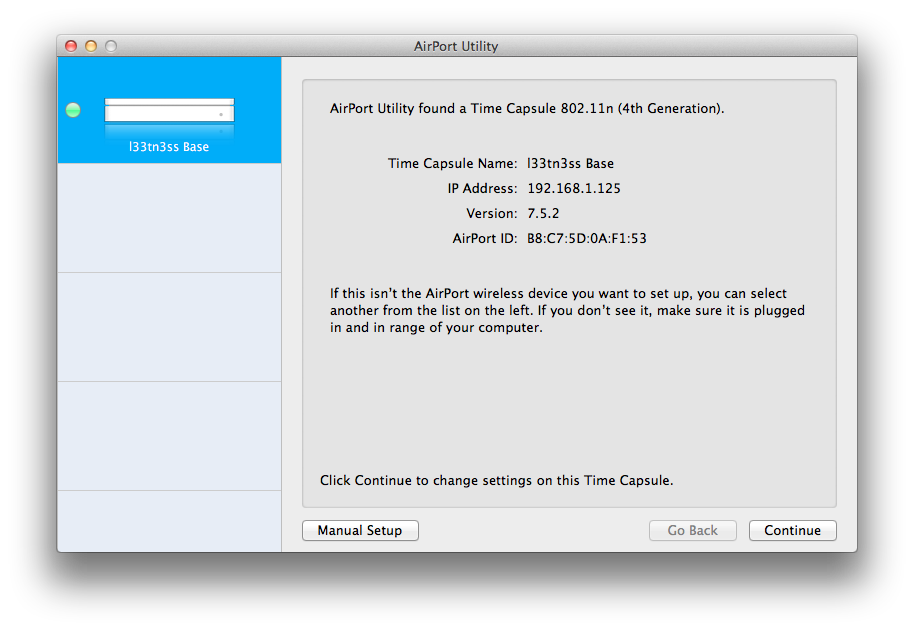
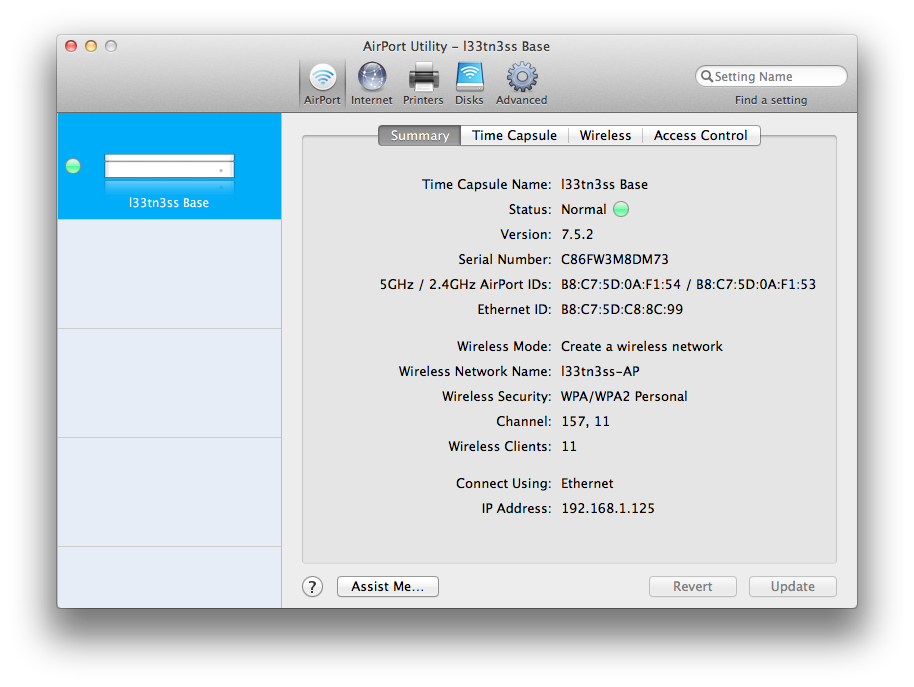
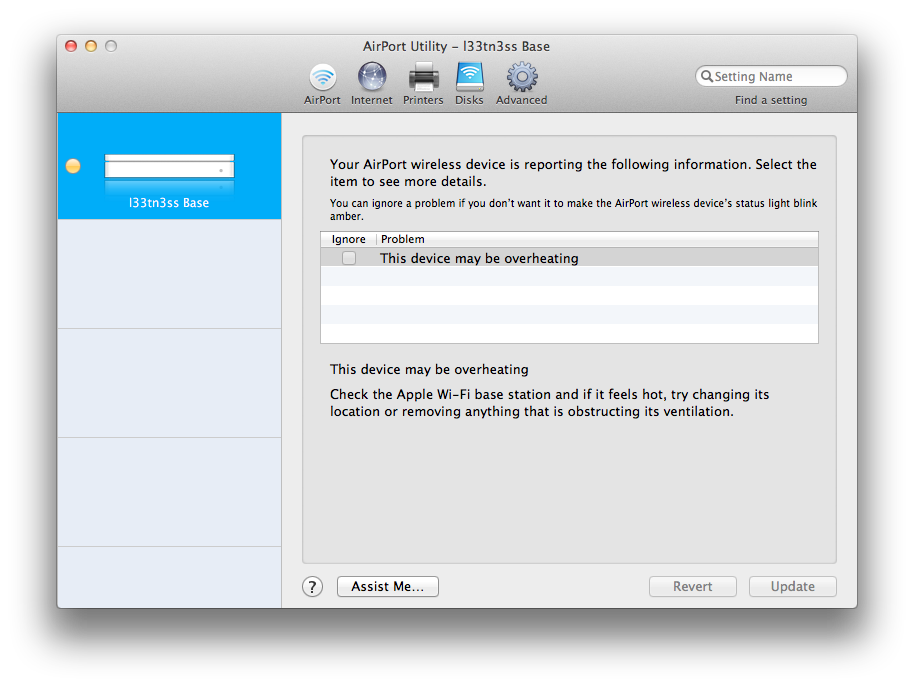
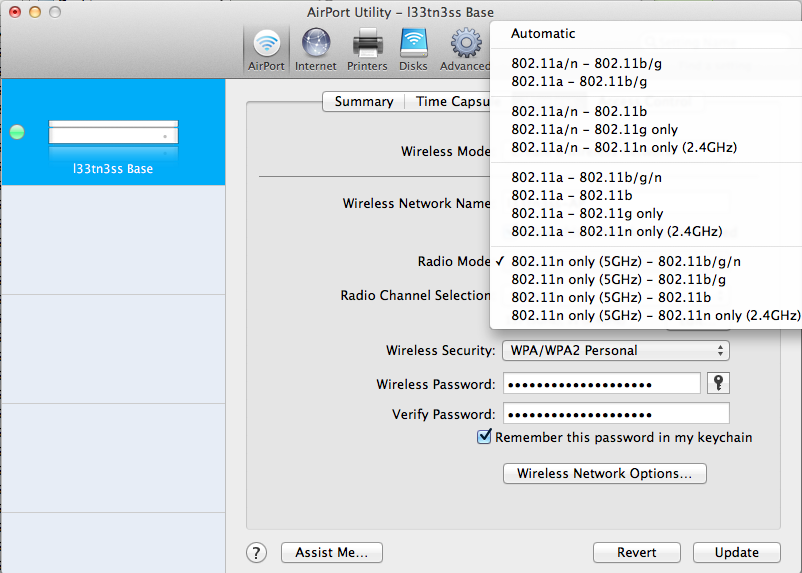
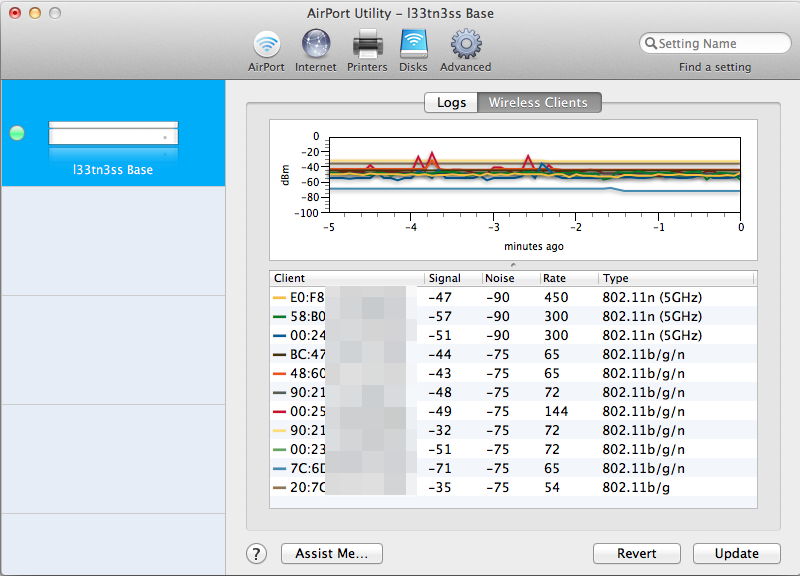


























90 Comments
View All Comments
geekd0m - Saturday, August 6, 2011 - link
I'll second the request for QOS and uPNP on these. I would love to get the Airport Extreme or Time Capsule for their solid performance, but really need the QOS....MGSsancho - Saturday, August 6, 2011 - link
http://www.anandtech.com/Gallery/Album/1282#13 passwordsBrian Klug - Saturday, August 6, 2011 - link
That's my placeholder password ;)-Brian
pius - Saturday, August 6, 2011 - link
Hi BrianThank you for a very thorough review! Based on your review I think I'm going to buy the new AirPort Extreme. I think I need two of them to reach the entire appartment. Should I instead then get one and then add an Express? Or will I then lose the advantages of the new Extreme? Also, is the Extreme any better that the Express when I don't need the USB and ethernet ports? I've heard about a device limit on the Express. Does that also apply if I only use it for extending the Extreme?
Brian Klug - Saturday, August 6, 2011 - link
I have an Express I originally intended to use to "extend" the network (really just WDS), but ran into all sorts of issues. I don't think they've updated that product in a while, and yeah the Extreme has much more power and range than the Express in general.-Brian
gameman733 - Saturday, August 6, 2011 - link
During the review, you mentioned that you ran into some trouble with Lenovo blocking the installation of mini-pcie wireless cards. I just wanted to let you know that this is definitely not the first time I've heard of it happening, and its not a recent thing.My old laptop, a Compaq Presario V2402US, purchased in 2005, didn't come with a wireless card. I went looking for a 3rd party wireless card (buying from HP didn't make sense when it came with a mini-pci slot available, and I could find a mini-pci card cheaper), and came across a page that mentioned several HP/Compaq laptops that did exactly what your Lenovo laptop did.
As I recall, it was only watching the device and vendor ID's of the card, and the bios could be modded to take any card, but this really shouldn't be necessary. The only close to legitimate reason I could think of was FCC clearance, but that doesn't make any sense either. Anyway, just wanted to share my experience.
Alchemy69 - Saturday, August 6, 2011 - link
Oh look, Apple have invented Wi-Fi. Expect lawsuitsrepoman27 - Saturday, August 6, 2011 - link
I bet it would work just fine. As long as you update the older model to version 7.5.2 of the AirPort Base Station and Time Capsule firmware first (available download from Apple), you should be good to go. The reference module has everything it needs, and the main board is the same hardware revision. No muss, no fuss.eBay has scads of listings for various Broadcom reference modules which can be used to upgrade older Macs, so I imagine it's only a matter of time before these hit the streets as well.
And it was an amazing review - everything I've been hoping for since I was looking at Hardmac's take apart photos back in June and noticed that Apple had switched from a Marvell to a Broadcom radio module.
Brian Klug - Saturday, August 6, 2011 - link
Thanks! Interesting, if the reference module BCM94331 comes up, I'll definitely give it a shot. I too bet it would work, I just wonder whether the device only gets flashed an image with the appropriate controller drivers depending on what "generation" it is, as opposed to actually looking at what card is installed.-Brian
tipoo - Saturday, August 6, 2011 - link
Are there any non-Apple routers using this new Broadcom wireless chip? Would they get the same performance with the same chip, or is there some added Apple-juice in there? No doubt this is a great router, just very pricey.